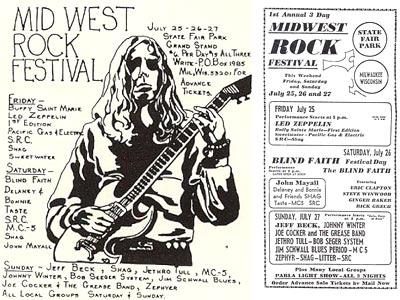
A poster and an advertisement for the Midwest Rock Festival at Wisconsin State Fair Park, which preceded Woodstock by three weeks.in 1969. Courtesy onmilwaukee.com
Part 2
Everything was changing, once again. San Francisco’s Grateful Dead, Jefferson Airplane, Big Brother and the Holding Company with Janis Joplin, and Quicksilver Messenger Service intoxicated the new audiences, as did the British Second Invasion bands, like the Eric Clapton spear-headed British power blues-rock trio Cream, Led Zeppelin, and Traffic, with Stevie Winwood, and progressive-rock groups like Pink Floyd, Genesis and Yes. Meanwhile, Milwaukee DJ Bob Reitman, on his free-form programs, “also educated, with his ‘Dear Doctor’ segment with a local physician addressing the drug scene in Milwaukee (and its risks).”
The West Coast musical tsunami rose, and hit Milwaukee with uncommon force, following the wildly successful 1967 Monterey International Pop Festival, with its breakout performances by Hendrix, Joplin, Otis Redding and Indian sitar virtuoso Ravi Shankar.
Perhaps the most accomplished Milwaukee band to embrace the psychedelic style and modern jazz was The Corporation, which recorded a self-titled 1969 debut album for Capitol, with a 19-minute take on Coltrane’s “India,” riding an “East-West”-like bass vamp, trippy Blues Project-like flute, and Larry Young-influenced organ. The Milwaukee power trio Ox (see photo below) took off on Cream’s blues-jamming style, with singer-bassist Jon Paris, who followed with a national solo career, which included recording with Johnny Winter and Bob Dylan. Another early local psychedelic band was Bloomsbury People, formed by multi-instrumentalist Sigmund Snopek III, which incorporated classical music and literary influences.
The real explosion occurred at the Midwest Rock Festival at State Fair Park on July 25, 26 and 27, 1969. The ambitious event preceded Woodstock by about one month. I attended all three days and recall birdlike fliers floating around, airily trumpeting something called “Three Days of Peace, Love & Music” in Woodstock, New York. Such glowing idealism filled the air those days. The Milwaukee festival had no sprawling countryside to luxuriate in funky au naturale digs. No “breakfast in bed for 300,000.”
But the lineup of talent on a flatbed truck on the State Fair racetrack proved extraordinary, and perhaps unprecedented in this city. The biggest name acts didn’t disappoint, including the sexy, blues-drenched Led Zeppelin (with brilliantly imaginative, and resourceful raga-like explorations by guitarist Jimmy Page), and the more exalted supergroup experiment Blind Faith, with former Cream members Eric Clapton and drummer Ginger Baker, and singer-keyboardist Stevie Winwood from Traffic, striving for some spiritual uplift “In the Presence of the Lord.”
Here’s a partial recording of Led Zeppelin’s set at the Midwest Rock Fest in 1969. Courtesy Misty Mountain Bootlegs
Yet Johnny Winter stuck to hard-driving blues as a new six-string gunslinger trying to cut the British guitar titans present, Clapton, Page and Jeff Beck, as did upstart Irish guitarist-singer-songwriter Rory Gallagher, of Taste, who hardly anyone had heard of. Was Gallagher’s star born in Milwaukee? He swiftly became a mighty Gaelic wind, and was soon universally respected by peers. Clapton credited Gallagher with “getting me back into the blues,” The Rolling Stones tried to get him to replace Mick Taylor.
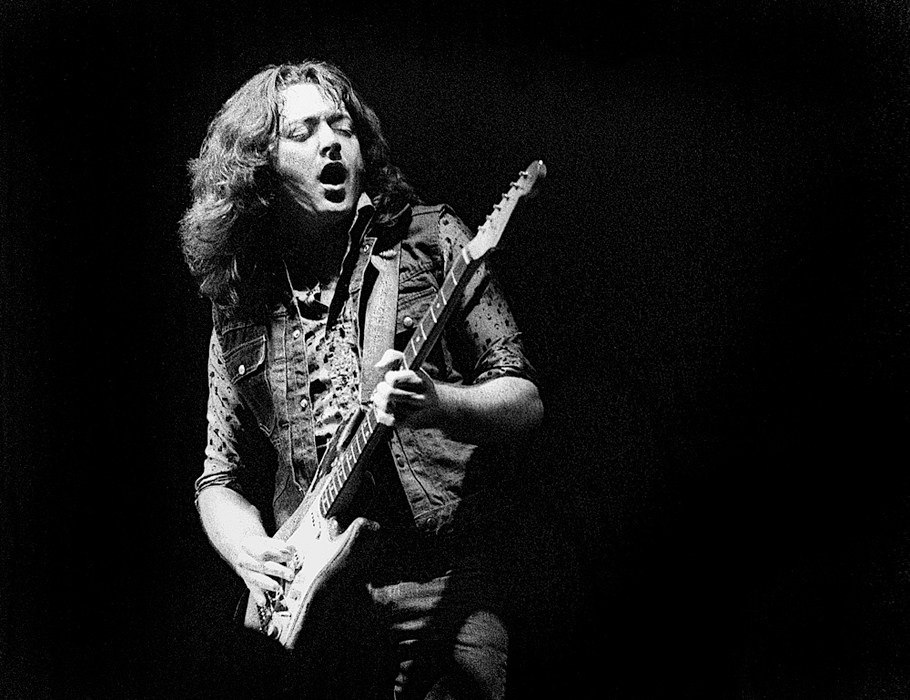
Amid several more famous guitarists, Irish guitarist-singer-songwriter Rory Gallagher (pictured in a 1971 concert) was a surprise hit with his band Taste, at the Milwaukee Rock Fest in 1969. Photo courtesy Rory Gallagher website.
Then, The First Edition with future superstar Kenny Rogers, “Just Dropped In” the fest with their hit song. Some of the most bracing music arrived from Detroit: the still-young and rocking Bob Seger System and the deliciously outrageous proto-punk band MC5.
The Milwaukee rock fest also had breathing space for soulful, folk-oriented music, like Buffy Sainte-Marie and the gospel-inflected Delaney and Bonnie, who so impressed Clapton that he hired them in his historic next venture, with guitarist Duane Allman, the album Layla, arguably Clapton’s career pinnacle. Alas, “blind faith” didn’t prevent Mother Nature from carping on Sunday, about what? All the unholy noise? Rain hit this festival hard, presaging water-logged Woodstock, and forcing cancellation of guitar-whiz Beck and Jethro Tull, with flute-toodling showman Ian Anderson.
“They tried to cover the stage with clear plastic sheeting to protect the performers,” recalled Mark Mueller of Sunday in the new book. “It did to a point, Joe Cocker came on and was outstanding, but the water build-up burst right over his head.” And in a one-fell splat! began the not so “dry run” for Cocker’s shaggy-dog, singin’ in the rain style, which he’d make truly famous the next month, amid Woodstock’s downpours.
Naylor recounts how the idea of a communal outdoor experience continued with the “Alternate Site,” first at Water Tower Park, on Lake and North Avenue. But clashes with police in 1970 led Ald. Vel Phillips and Mayor Henry Maier to find an alternative location, west of Lincoln Memorial Drive across from McKinley Beach. “It’s a gas to play for these people,” said Sam Friedman of the Hound Dog Band, at the time. “And it’s good exposure. We got nothing else to do on Sunday and we get a wider group of people here, not like playing in a club.” Sunday concerts averaged about 5,000 people during the early 1970s. But the volatile relationship between crowds and police forced another site relocation and eventually crowds dwindled, but the alt-concerts did continue into the 1990s.
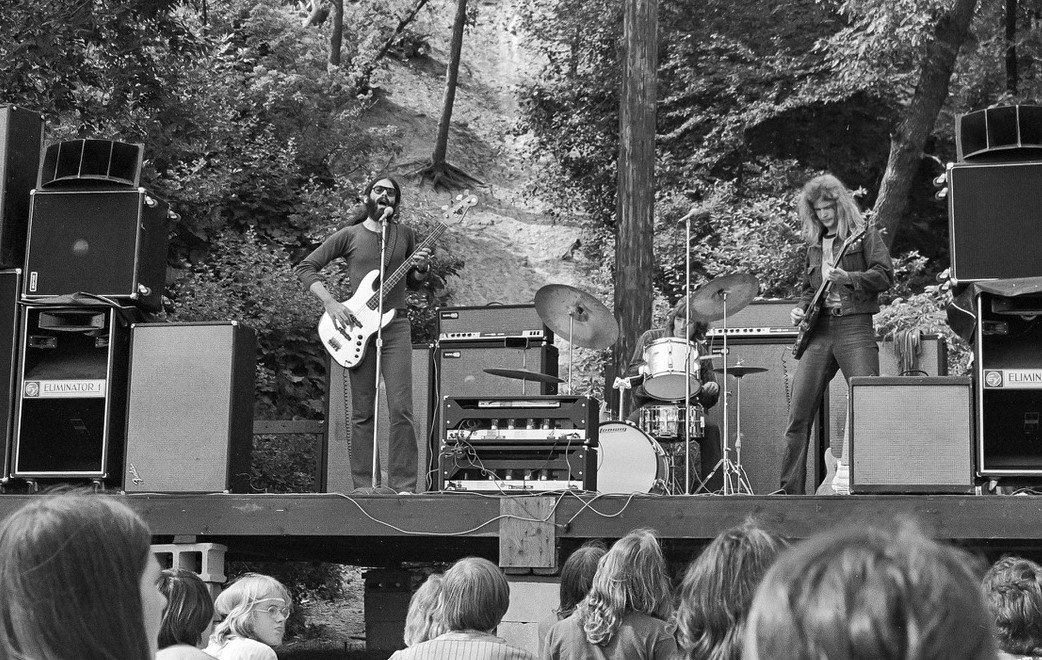
Milwaukee power rock trio Ox (Jon Paris, vocals & bass; Brad Seip, drums; and Bob Metzger, guitar) put plenty of Cream in their coffee at the Alternate Site, across from McKinley Beach on Lincoln Memorial Drive in 1972. Photo by Rich Zimmerman www.richzimmermann.com
Night clubs remained a place to always hear live music, and the city that made beer famous had a strong tradition for this, especially local crime boss Frank Balistrieri, who “had a passion for managing bar-side entertainment in many of his theater district establishments,” writes Rob Lewis. “Frank used out-of-town connection, and his experience in booking” to turn the first floor of now-razed Hotel Antlers into the city’s first world-class showcase nightclub for rock-oriented music, called The Scene, in 1965.
With an encircling balcony, it offered an intimate concert experience. Along with top local bands, it hosted Chuck Berry and Ray Charles (each for five nights), Stevie Wonder, Smokey Robinson, Cream, Jimi Hendrix, Frank Zappa, Paul Butterfield, Miles Davis, and the original Allman Brothers, in September 1970, shortly before Duane Allman and bassist Berry Oakley died. I witnessed that soulfully-virtuosic show, marking the rise of Southern rock.
The folksy-cozy east-side Avant Garde offered local and touring folk-rock, blues and experimental music, and poetry readings, a legacy perhaps best documented by great Chicago blues man Magic Sam’s sweaty, searing album Live at the Avant Garde, a 1968 performance released by Delmark Record in 2013. (See review in Shepherd Express.) The club helped cultivate the emergence of mighty Milwaukee harmonica player Jim Liban, who teamed up with another bandleader, Junior Brantley and guitarist-singer Sam McCue for a powerhouse band called Knu Bluze. After McCue left, they went to San Francisco, with ace Milwaukee organist Howard Wales. Renamed as A.B. Skhy, they recorded two fiery, swinging albums for MGM. Jimi Hendrix facilitated that record contract after hearing and jamming with them. This band evolved into Short Stuff, a name ironically carrying long staying power.
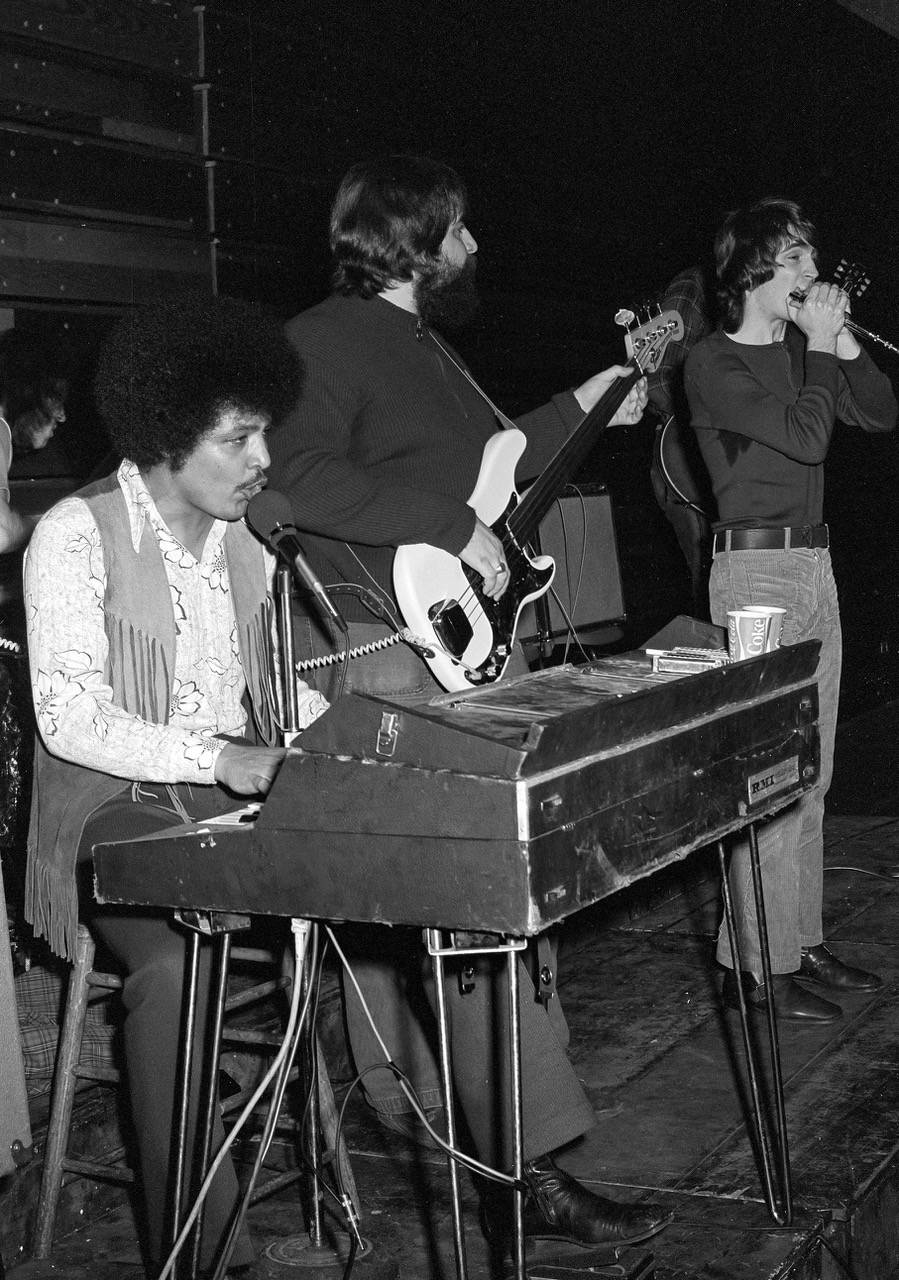
Milwaukee’s Short Stuff — a blues/R&B/rock band led by Junior Brantley (left), and Jim Liban (right) — stole the show opening for Big Brother and the Holding Company in 1972.
It’s a measure of this ensemble’s potency to consider a concert the book only acknowledges with a photo and caption (above). At the Whitefish Bay High School auditorium in 1972, Short Stuff opened for Big Brother and the Holding Company, admittedly weakened by the loss of grit-to-the-core singer Janis Joplin. Short Stuff’s wiry Jim Liban channeled his inner Mick Jagger, prowling up and down a stage runway, blowing rhythmic, wailing harp sorties, whipping the crowd into a lather. By the time he and the funky band ceased, the ensuing Big Brother stood reduced to little brother. It was close to the best opening act I’ve ever seen, certainly by a local band. 4
Local fan Jim Pendergast claims he overheard, at Humpin’ Hanna’s nightclub, harmonica titan Paul Butterfield tell Liban: “James, you are the second best blues harmonica player in the world.”
Speaking of legendary performances, Milwaukee preempted rock history again by a few weeks in October 1975, an extraordinary event surprisingly overlooked in this book. Bruce Springsteen changed everything in rock again, almost by himself. And he stood on the cusp of superstardom on an electrifying night in Milwaukee rock history. A phoned-in bomb scare forced emcee Bob Reitman to ask the packed house to leave the Uptown Theater, shortly into Springsteen’s set, at least until midnight. Bruce vowed to finish when the coast was clear. At midnight, it appeared almost all 1,800 of us concertgoers had returned, with Springsteen and the E-Street Band, and with a vengeance.
Time had stood still, for fate. Springsteen and his band had hung out at the Pfister Hotel bar, “drinking our skulls out,” he told the crowd. His sweat and soul flew across the jubilant crowd until 2 a.m., one of the earliest of The Boss’s legend-making performances. 5 Later that month, TIME and Newsweek plastered him simultaneously on their covers. Here’s a link to a recording of the Springsteen Uptown concert with Piet Levy’s 2015 Journal-Sentinel article about it.
I’ve focused largely on the late ‘60s and early ‘70s because they were crucial years for rock’s transformative cultural and political roles and, regarding live music, perhaps no more significantly than the popularization of large outdoor festivals. 6 But the book impressively forges on to 2000. An in-depth chapter on Milwaukee blues is authored by Sonia Khatchadourian (also a popular “Blues Drive” DJ on WMSE radio). She covers, among others, the careers of Liban, Brantley, Jeff Dagenhardt, Steve Cohen, Jon Paris, Kenny Arnold and James Solberg, of Dynamite Duck fame recordings on Motown and Alligator records), and whose James Solberg Band won two W.C. Handy Awards for best blues band in 1996 and 1997.
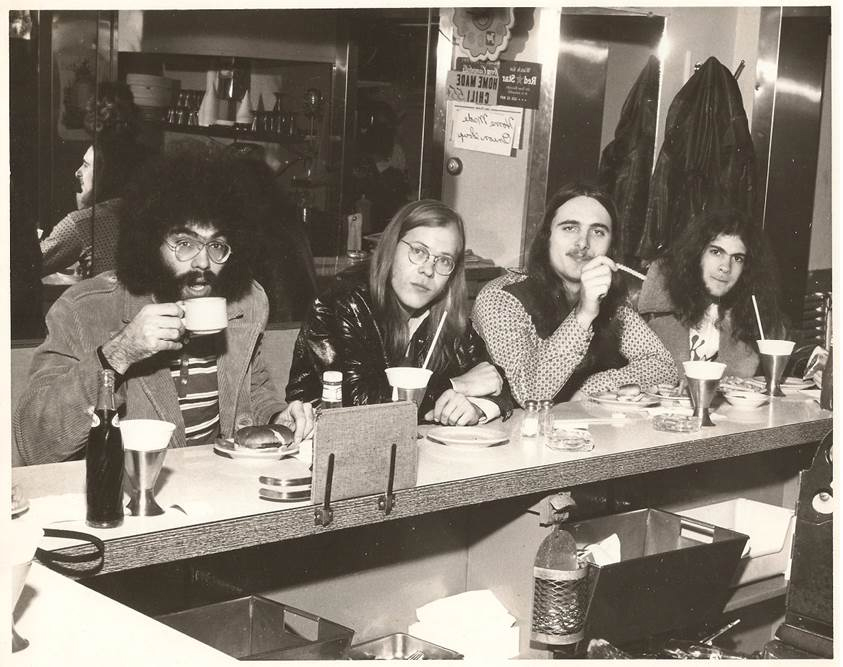
The Dynamite Duck blues band at Ma Fischer’s on Milwaukee’s east side. (l-r) Jon Paris, James Solberg, Mark Lillis, Danny Shmitt. Photo by Tom Hayes
Rose Trupiano relates the emergence of Milwaukee rock women, starting with the groundbreaking GTOs (or “Girls Take Over”) formed in 1960.
One artist’s account is quite notable, the extraordinary and tragic story of Milwaukee’s first hard-rock female sex symbol. 1969 marked the local arrival of Constance Mierzwiak, an Ohio-born, high-school drop-out. She dubbed herself Ruby Jones and the Ruby Jones Band’s 1971 debut album included an attention-grabbing single covering The Young Rascals’ “You Better Run,” and Curtis Mayfield’s “Stone Junkie.” In 1972, Jim “Dandy” Magrum, lead singer of Black Oak Arkansas, heard Ruby sing and convinced her to join his band as a back-up singer. Her breakout as a lead singer came on an acclaimed West Coast stint with the Florida band Blackfoot.
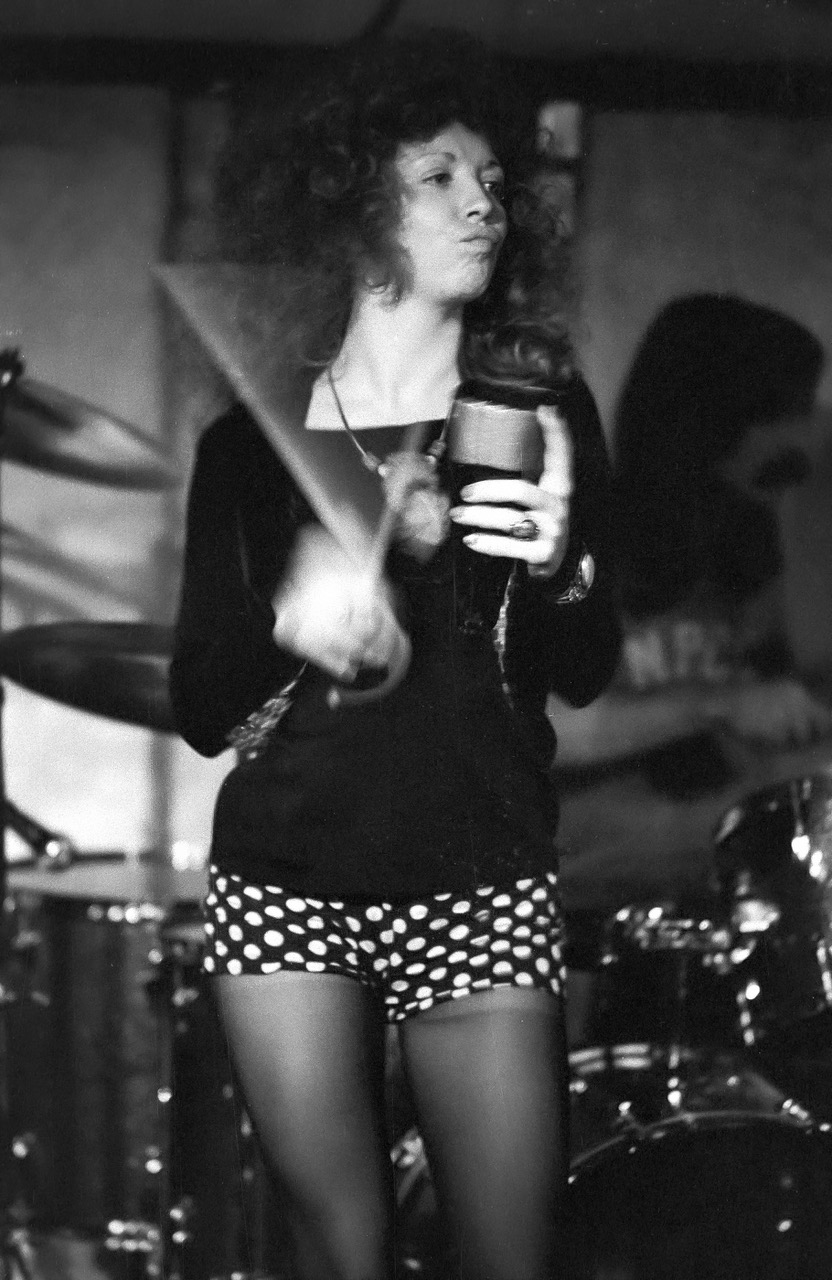
Singer Ruby Starr at Humpin’ Hannah’s nightclub in 1975. Photo by Rich Zimmermann
Now dubbed Ruby Starr, and sporting a flaming mountain of red hair, she began touring with the Wisconsin band Grey Ghost. By 1976, her second solo LP covered Paul McCartney’s “Maybe I’m Amazed,” which the band performed on the national TV show Midnight Special. Her next band incarnation, Grey-Star, delivered the 1983 album Telephone Sex, pulsing with savvy covers and originals. The act began winning Wisconsin Area Music Industry awards and toured, opening for Van Halen, The Allman Brothers and Cheap Trick, which led to opening for The Who in the celebrated British quartet’s local debut at the Milwaukee Arena, which included Starr’s power-packed cover of Joplin’s “Piece of my Heart.”
That palpable heartbreak song, performed on December 7, 1982, the “day of infamy,” was perhaps a harbinger of doom. Ruby pushed her hard-driving career until severe headaches struck her down. Her old friend Mudslide took her to a doctor who diagnosed her with lung cancer and a brain tumor – and six months to live. Ruby died a year later, at 45. In 1995, she became the first woman inducted into the WAMI Hall of Fame.
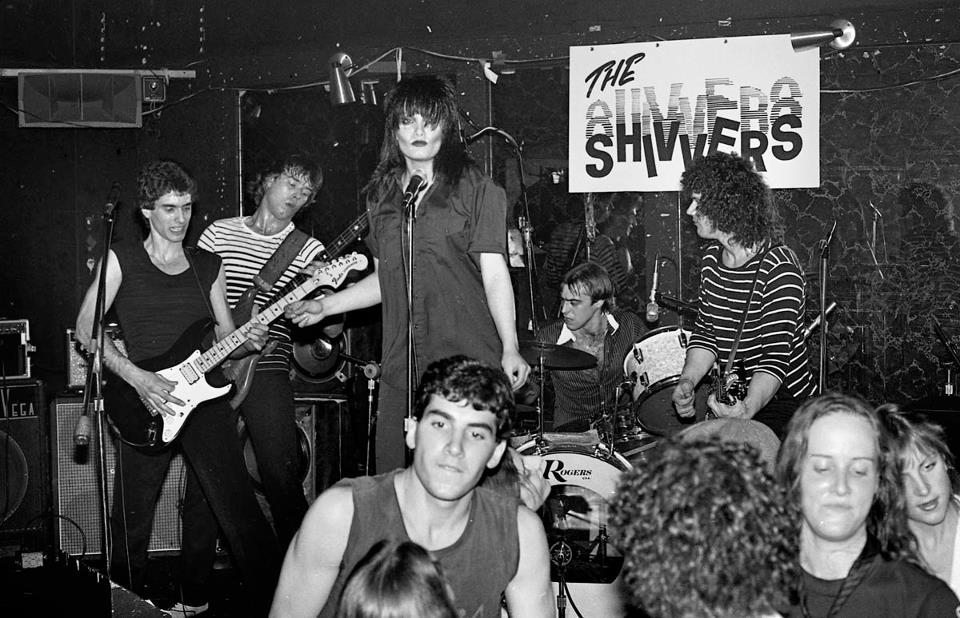
Lead singer Jill Kossoris (center) and the Shivvers perform their power pop/punk music in the 1970s. Courtesy Jill Kossoris.
Another notable woman-fronted Milwaukee band, the Shivvers with Jill Kossoris, was characterized by local critic Bobby Tanzilo as “part Blondie, part Raspberries,” power-pop plus. They missed out on a national record contract despite considerable support from Raspberries front man Eric Carmen. Trupiano sums them up: “Although it took decades for the Shivvers’ songs to be released, their music and lyrics are timeless and just as original and captivating today…”
Also highlighted among women rockers are Julie Brandenburg, Ronnie Nyles, Michelle Anthony, and the powerhouse blues-rocking singer-songwriter and guitarist, Sue DaBaco.
Dave Luhrssen and Evan Rytlewski cover Milwaukee punk and post-punk era with masterful authority, which I can’t do justice to here without this review running on. However, Mark “Black Dog” Shurilla’s The Black Holes was perhaps the quintessential Milwaukee punk/new wave band, especially with “Warren Spahn,” their 1979 local chart best-seller. “The band lip-synched their record before 20,000 baseball fans in County Stadium as Spahn (arguably baseball’s greatest left-handed pitcher) circled the field, waving to the stands.” Shurilla was another young-at-heart Milwaukee rocker who died before his time. But he’s not forgotten. Here’s a video of
The Black Holes singing “Warren Spahn” at Milwaukee County Stadium, in 1979, with Spahn throwing pitches to catcher Bob Uecker.
In this chapter we also learn the fabled story of the folk-punk Violent Femmes’ improbable rise from street-corner busking to becoming the city’s most famous rock band, and Jerry Harrison’s with the Talking Heads, of The BoDeans, Die Kreuzen, The Haskels, Oil Tasters and many more.
Because there are multiple authors, there’s no attempt to build an overarching Milwaukee rock culture theme, which may be yet to be told. But the book does invite us to connect some of its many resonant dots. Sam “The Fountainhead” McCue might provide a mythic story arc for “the gathering place by the waters,” as the Native American word “Milwaukee” translates. Perhaps, were this a warm weather city, the outdoor events might’ve mushroomed further, year-round. The big music fest idealism suffered a blow with the tragic killing of an audience member right beneath the stage at the Altamont Free Concert during a Rolling Stones performance, in December 1969.
Nevertheless, important large and smaller outdoor concerts do continue here (eg. “the world’s largest” music event, Summerfest, the 25th Farm Aid at Miller Park in 2010, among many neighborhood events, Bay View’s exemplary “Chill on the Hill,” and numerous ethnic fests). So the communal value lives on variously. Local bands and artists really struggled through the disco era, and now compete with many home and personal entertainment alternatives.
Before such abstracting devices fully transform us into walking cocoons, the many values of live music – from the powerful to the nuanced, and to the stimulus of regional economy – ought to be discussed, argued and advanced through private and municipal resources, proportionate to scale, as much as Chicago does with its music festivals. The nightclub experience remains a lifeline to rock vernaculars, to human vitality, fellowship and creative wellsprings.
Further still, the large outdoor gatherings, amid the elements, may be the only cultural activity that rivals big sports events for fortifying community spirit and helping to counter the tribalism plaguing us today.
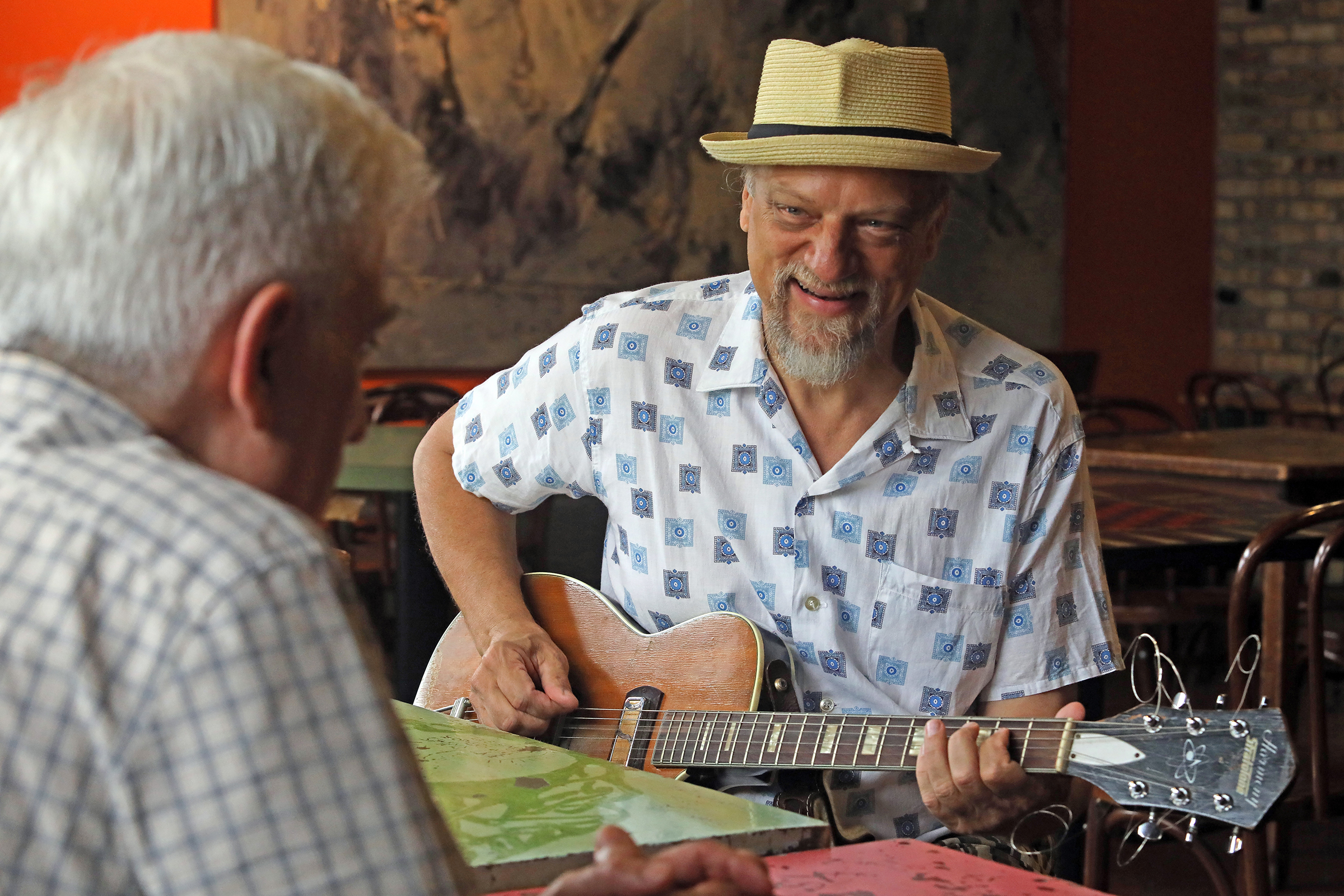
“Milwaukee Rock and Roll” co-editor Phillip Naylor interviews Paul Cebar, a remarkably voracious absorber and synthesizer of musical styles, from American to world musics, “a sonic explorer.” Photo by Dan Johnson. Courtesy MU Press.
Milwaukee Rock and Roll ends with an ingenious twist, a chapter on three “Milwaukee Sonic Explorers,” who often strayed far beyond rock conventions. Gary Huckleberry, Sigmund Snopek III, and Paul Cebar sound nothing at all like each other. All are ingenious and intelligent receptacles of many influences – comparable to the first local-scene “fountainhead” Sam McCue – who give so much back, in their own hybrid vernacular voices. They reveal how a Midwest city can become its own sort of crossroads for music. Too often, among cultural arbiters, everybody pass us by, to paraphrase blues legend Robert Johnson. With this book, that may begin to change.
___________
The photo of Rory Gallagher and the links to the Led Zeppelin live recording and The Black Holes video are not from Milwaukee Rock and Roll. All other photos in this part of the review are from the book.
NOTES
1 Les Paul is put in his historical context in the impressive recent book by Ian S. Port, The Birth of Loud: Leo Fender, Les Paul, and the Guitar-Pioneering Rivalry That Shaped Rock ‘n’ Roll
2 I detail the extraordinary on-air radio station experience of announcing Marvin Gaye’s death to a “contemporary urban music” audience in my forthcoming book Voices in the River: The Jazz Message to Democracy. I also co-hosted (rotating weeks with Paul Cebar and Steve Cohen) an eclectic music program on WMSE in the late-1980s. 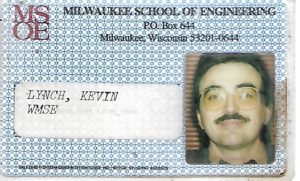
3 In a comment not in the book, Clapton critiqued the Led Zeppelin set, led by his fellow former Yardbirds guitarist Jimmy Page. “They were very loud,” Clapton later remembers. “I thought it was unnecessarily loud. I liked some of it; I really did like some of it. But a lot of it was just too much. They overemphasized whatever point they were making, I thought.” Reliquary http://yup-yup-mark.blogspot.com/
4 Steve Cohen is perhaps the only other Milwaukee harmonica player comparable to Liban. A deeply knowledgeable past-master also of chromatic harmonica, a singer and guitarist, Cohen is best known as co-leader of Leroy Airmaster, with guitarist Bill Stone, with whom he’s played with since high school. Cohen has also recorded and worked with the city’s greatest rock guitar virtuoso, Greg Koch. Cohen also maintains a excellent country-blues duo with Peter Roller.
5 The police “tore the theater apart,” security chief Terry Cullen told the Journal-Sentinel 40 years later. No bomb was found.
6. After having attend two concerts at Red Rocks Amphitheater in Morrison, Colorado, I would concur with much popular opinion that it’s the best outdoor venue for a large rock or pop concert in America. Even going to the physical site, high in the mountains, is a bit of a pilgrimage, suggesting the sharing of something significant with a huge “faithful,” lovers of rock and other vernacular musics, not to mention classical. Note in the Rolling Stone survey here, historic Alpine Valley Music Theater in East Troy, WI — a mecca for jam band fans (of The Grateful Dead, Phish etc.) — is ranked the 6th best venue:
https://www.rollingstone.com/music/music-lists/the-best-amphitheaters-in-america-47179/


Hey there Kevin! This is JD, the founding father of the rather very well received “pop/punk/original Milwaukee rock band”MANNEQUIN “! And I’m just wondering why there’s no mention of us in the early history of Milwaukee rock bands that became very big here during the early 70’s and on into the 80’s too!(I mean after all,I see that you included a photo and review of”The Shivers”who had jimmy eainelli playing lead guitar with them, and who made the switch and became my 1st.lead guitarist w/”MANNEQUIN “!? And we also are inducted into the”Wall Of Fame “@TurnerHall”so we’ve paid our dues and certainly deserve CREDIT WHERE CREDIT IS DUE! Come on now! J.ames D.ooley@thebiggestkahuna70@gmail.com